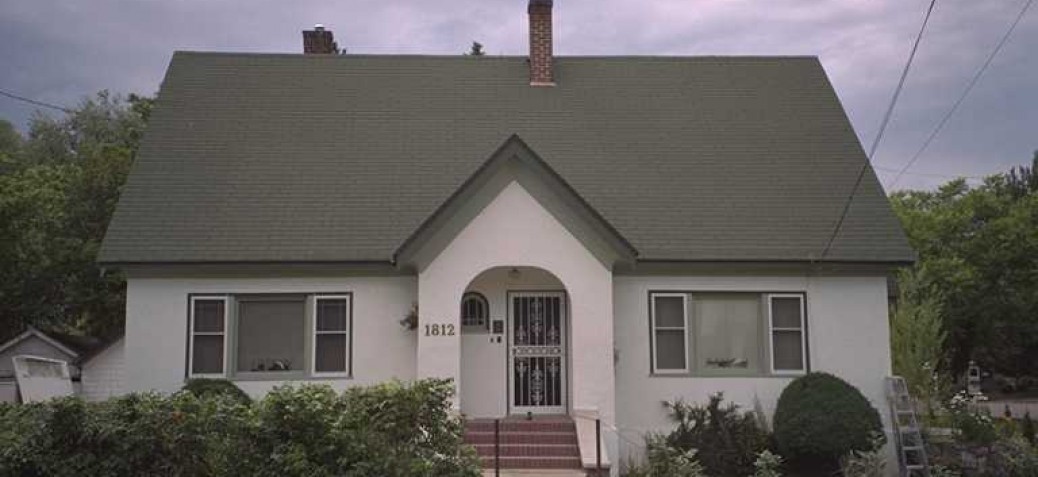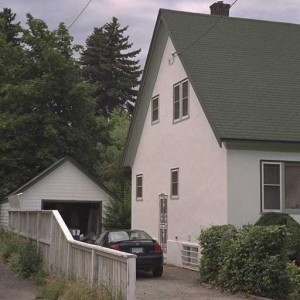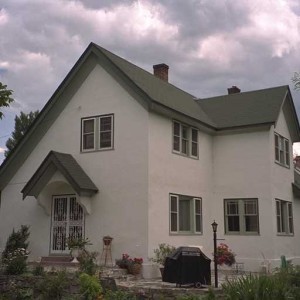1812 Marshall St
Place Description
The historic place is the two-storey, stuccoed wood-frame structure at 1812 Marshall Street, a cottage-style house built in 1931 in the Marshall Street Heritage Conservation Area, in Kelowna's South Central neighbourhood.
Heritage Value
The house has heritage value because two of its past owners, Roy Staples and W.B. Hughes-Games, have local historical significance. The former was a major player in vital conflicts in the fruit marketing, and the latter was a business and political leader in the community. The house also has value because it is representative of modest but ample residences built during the 1930s.
The cottage-style house was built for Roy Baird Staples in 1931 by Hector Maranda, a local builder. Staples had been a fruit-grower and manager of a cooperative packing house at Creston from 1911 to 1920. In the latter year he organized the independent Staples Fruit Company Ltd. of Creston, which was actually owned by the Nash, Simington Co. Ltd. fruit-wholesaling combine; and later in the 1920s he set up several other fruit-shipping businesses secretly controlled by Dominion Fruit Ltd., which had succeeded the old Nash combine.
Staples was associated with Sales Service Ltd., which was formed in 1926 to act as a sales agency for the independent shippers who opposed Associated Growers of British Columbia Ltd., the cooperative shippers' sales agency. By the 1930s Staples was the manager of Sales Service, based in Kelowna. In 1939 the McGregor Commission, which ruled under authority of the Combines Investigation Act, found that Sales Service Ltd. was part of an illegal combine. When the matter was brought to trial in 1940, however, the company was found not guilty. Sales Service Ltd. ceased to operate after B.C. Tree Fruits Ltd. was set up as the compulsory central selling agency in 1939. Staples returned at that time to the Creston Valley, where he had extensive land holdings, and went into the business of growing pea seed.
William B. Hughes-Games, who was also locally significant, purchased the house in the early 1950s and lived here until at least 1970. He emigrated to Vancouver from England in 1911. After service in the Seaforth Highlanders in World War I, Hughes-Games arrived in Kelowna in 1926 and immediately became active in the community. He served as secretary of the Kelowna Hospital Board from 1927 to 1937, Mayor of Kelowna from 1947 to 1951, and chairman of the Okanagan Regional Library Board from 1951 to 1956. His term as mayor saw the building of the Civic Centre, City Hall, and extensive sewer construction and road paving, and land was acquired at that time for government buildings.
Hughes-Games bought into the hardware business of Thomas Lawson Ltd. in 1936, and after it was reorganized as George A. Meikle Ltd. in 1937 he served as its secretary-treasurer.
The house is a modest exercise in the vernacular cottage manner, a plain style that has no direct historical references and anticipates the architectural modernism of Post-War British Columbia. It is typical of the homes of many middle-class Kelowna residents in a number of neighbourhoods. It reads as a one-storey house from the front and a two-storey house at the rear.
Character Defining Elements
- Vernacular Cottage style, characterized by clean lines and a simple symmetrical street elevation
- Steep gable roof with smaller gable projection at the rear
- Brick chimneys
- Projecting entry at the centre of the house with a small gable roof and arches on the front and sides
- Decorative wrought-iron-trimmed double entrance doors
- Wood double-hung windows, with one-over-one sashes in frames of two and three, and picture windows between double-hung windows on the front elevation
- Walls are finished in stucco painted green, with white painted trim
- Mill Creek is at the rear of the property
- Many shrubs and trees, and an original rock patio with fountain






